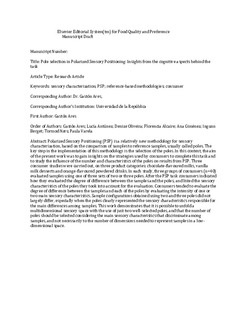| dc.contributor.author | Ares, Gastón | |
| dc.contributor.author | Antúnez, Lucía | |
| dc.contributor.author | Oliveira, Denize | |
| dc.contributor.author | Alcaire, Florencia | |
| dc.contributor.author | Giménez, Ana | |
| dc.contributor.author | Berget, Ingunn | |
| dc.contributor.author | Næs, Tormod | |
| dc.contributor.author | Tomasco, Paula Alejandra Varela | |
| dc.date.accessioned | 2018-02-07T07:37:05Z | |
| dc.date.available | 2018-02-07T07:37:05Z | |
| dc.date.created | 2015-09-09T14:11:39Z | |
| dc.date.issued | 2015 | |
| dc.identifier.citation | Food Quality and Preference. 2015, 46 48-57. | |
| dc.identifier.issn | 0950-3293 | |
| dc.identifier.uri | http://hdl.handle.net/11250/2483091 | |
| dc.description.abstract | Background The need for precise and stable taxonomic classification is highly relevant in modern microbiology. Parallel to the explosion in the amount of sequence data accessible, there has also been a shift in focus for classification methods. Previously, alignment-based methods were the most applicable tools. Now, methods based on counting K-mers by sliding windows are the most interesting classification approach with respect to both speed and accuracy. Here, we present a systematic comparison on five different K-mer based classification methods for the 16S rRNA gene. The methods differ from each other both in data usage and modelling strategies. We have based our study on the commonly known and well-used naïve Bayes classifier from the RDP project, and four other methods were implemented and tested on two different data sets, on full-length sequences as well as fragments of typical read-length. Results The difference in classification error obtained by the methods seemed to be small, but they were stable and for both data sets tested. The Preprocessed nearest-neighbour (PLSNN) method performed best for full-length 16S rRNA sequences, significantly better than the naïve Bayes RDP method. On fragmented sequences the naïve Bayes Multinomial method performed best, significantly better than all other methods. For both data sets explored, and on both full-length and fragmented sequences, all the five methods reached an error-plateau. Conclusions We conclude that no K-mer based method is universally best for classifying both full-length sequences and fragments (reads). All methods approach an error plateau indicating improved training data is needed to improve classification from here. Classification errors occur most frequent for genera with few sequences present. For improving the taxonomy and testing new classification methods, the need for a better and more universal and robust training data set is crucial. | |
| dc.language.iso | eng | |
| dc.title | Pole selection in Polarized Sensory Positioning: Insights from the cognitive aspects behind the task | |
| dc.type | Peer reviewed | |
| dc.type | Journal article | |
| dc.description.version | submittedVersion | |
| dc.source.pagenumber | 48-57 | |
| dc.source.volume | 46 | |
| dc.source.journal | Food Quality and Preference | |
| dc.identifier.doi | 10.1016/j.foodqual.2015.07.003 | |
| dc.identifier.cristin | 1262944 | |
| dc.relation.project | Norges forskningsråd: 225062 | |
| dc.relation.project | Norges forskningsråd: 225096 | |
| dc.relation.project | Nofima AS: 201308 | |
| dc.relation.project | Nofima AS: 201302 | |
| dc.relation.project | Nofima AS: 10841 | |
| dc.relation.project | Norges forskningsråd: 233684 | |
| cristin.unitcode | 7543,3,2,0 | |
| cristin.unitcode | 7543,3,3,0 | |
| cristin.unitname | Råvare og prosess | |
| cristin.unitname | Sensorikk, forbruker og innovasjon | |
| cristin.ispublished | true | |
| cristin.fulltext | preprint | |
| cristin.qualitycode | 1 | |
